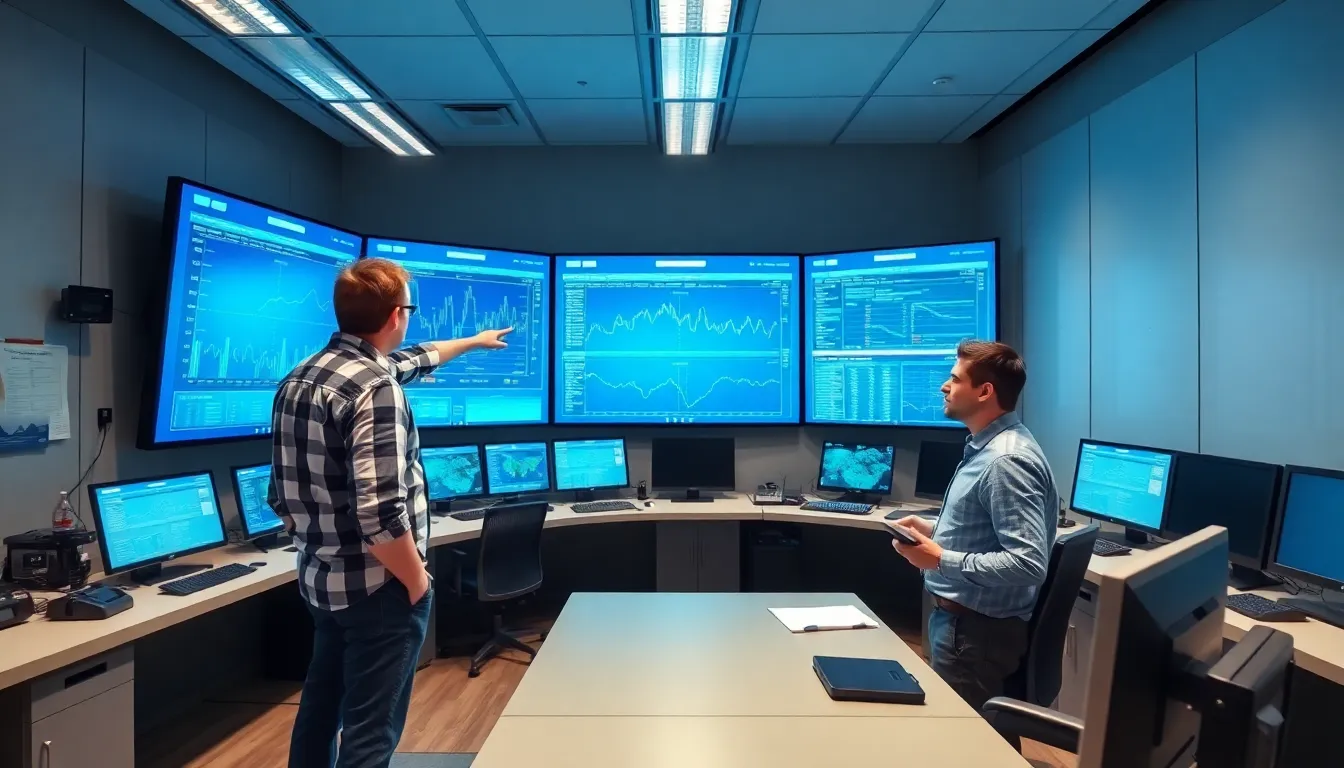Imagine a world where your electricity is as smart as your smartphone. Welcome to the realm of smart grid technology, where energy management meets high-tech wizardry. Gone are the days of outdated power systems that leave you in the dark—literally. This innovative approach not only optimizes energy use but also empowers consumers to take control of their electricity bills.
Table of Contents
ToggleOverview of Smart Grid Technology
Smart grid technology revolutionizes energy distribution and consumption. It enables real-time communication between utilities and consumers, enhancing efficiency and control.
Definition and Purpose
Smart grid technology refers to an upgraded electricity supply network that incorporates advanced communication and automation. This system optimizes the generation, distribution, and consumption of electricity. It aims to increase reliability, reduce costs, and facilitate the integration of renewable energy sources. Consumers enjoy better visibility into their energy usage, leading to more informed decisions about energy consumption. By coordinating with smart devices, the smart grid helps manage power loads and reduce peak demand.
Key Components
Key components of smart grid technology include advanced metering infrastructure, sensors, and communication networks. Advanced metering infrastructure allows two-way communication between utilities and consumers. Sensors enhance grid monitoring by providing real-time data on electricity flow and performance. Communication networks transmit data swiftly across the grid, enabling rapid response to outages and demand fluctuations. Additionally, demand response systems empower consumers to adjust their energy use during peak times. Integration of renewable energy sources further strengthens the grid’s efficiency and sustainability.
Benefits of Smart Grid Technology

Smart grid technology provides numerous advantages, transforming energy management. Improved efficiency and enhanced reliability stand out as key benefits.
Improved Efficiency
Smart grids optimize energy distribution, reducing waste during transmission. They utilize real-time data, allowing utilities to efficiently balance supply and demand. Automated systems respond swiftly to fluctuations, minimizing outages and ensuring consistent power flow. Consumers enjoy access to energy usage information, enabling them to make informed decisions. Many utilities implement demand response programs, encouraging users to modify their consumption patterns during peak times. Such initiatives lead to decreased energy costs while enhancing overall grid performance. In 2021, smart grid implementations led to a reported 10% increase in efficiency in several regions, showcasing its effectiveness in energy management.
Enhanced Reliability
Smart grids increase reliability by integrating advanced technologies. They feature sensors that monitor conditions throughout the network, providing early warnings of potential failures. Utilities can identify and address issues before they escalate, reducing downtime. Continuous communication between devices ensures rapid responses during outages, keeping homes and businesses powered. The resilience of the grid allows for better integration of renewable energy sources, contributing to a cleaner energy future. According to the U.S. Department of Energy, smart grid technologies could improve system reliability by up to 30%. This improvement significantly benefits consumers and utilities, fostering greater confidence in the electricity supply.
Challenges in Implementing Smart Grid Technology
Implementing smart grid technology presents notable challenges. Addressing these obstacles ensures successful integration and operation.
High Costs
High costs are significant barriers to smart grid implementation. Initial investments for infrastructure upgrades, advanced metering systems, and communication networks can exceed millions of dollars. Utilities often face financial strain when weighing these expenditures against potential long-term benefits. Consumer reluctance to bear increased costs also complicates the situation. Research indicates that nearly 50% of consumers prefer minimal rate increases, which limits utility investment strategies. Funding programs and incentives from governments or private sectors can alleviate some of these financial burdens, fostering a smoother transition to smart grids.
Data Security Concerns
Data security concerns pose risks to smart grid technology. The interconnected nature of smart grids makes them vulnerable to cyber threats. Malicious attacks could disrupt energy distribution or compromise consumer information. According to the U.S. Department of Energy, over 80% of utilities fear cyber intrusions. Implementing rigorous security measures is essential to defend against potential breaches. Regular risk assessments and updated protocols help safeguard sensitive data. Ensuring a high level of data protection builds consumer trust, which is crucial for successful adoption.
Future Trends in Smart Grid Technology
Smart grid technology continues to evolve, with future trends focusing on enhanced integration and advanced systems. These developments improve energy efficiency and support sustainable practices.
Integration of Renewable Energy
Strong emphasis on integrating renewable energy sources shapes the future of smart grid technology. Solar panels and wind turbines contribute significantly to energy production, reducing reliance on fossil fuels. As renewable energy becomes more available, smart grids allow for real-time data monitoring to manage energy flow effectively. According to the U.S. Department of Energy, renewables could make up 50% of energy generation by 2030. Consumers can access this clean energy efficiently through smart grids, enhancing their energy options. Increased flexibility in energy distribution promotes grid resilience and sustainability.
Advancements in IoT
Advancements in the Internet of Things (IoT) fundamentally transform smart grid technology. Smart meters, sensors, and connected devices interact seamlessly, providing valuable data for enhanced energy management. With these interconnected systems, utilities gain insights into consumption patterns and grid performance. Over 70% of energy utilities consider IoT-driven solutions essential for future operations. Enhanced automation and data analytics allow for quick responses to demand fluctuations, maintaining system stability. IoT enables consumers to monitor their energy use, promoting significant reductions in consumption and costs.
Smart grid technology is revolutionizing the energy landscape by enhancing efficiency and reliability. With its ability to integrate renewable energy sources and leverage real-time data, it paves the way for a more sustainable future. The challenges of implementation, including costs and security, are significant but can be addressed through innovative funding solutions and robust cybersecurity measures. As the industry evolves, the continued adoption of smart grids will play a crucial role in transforming how energy is consumed and managed. Embracing these advancements will not only benefit consumers but also contribute to a more resilient and environmentally friendly energy infrastructure.





